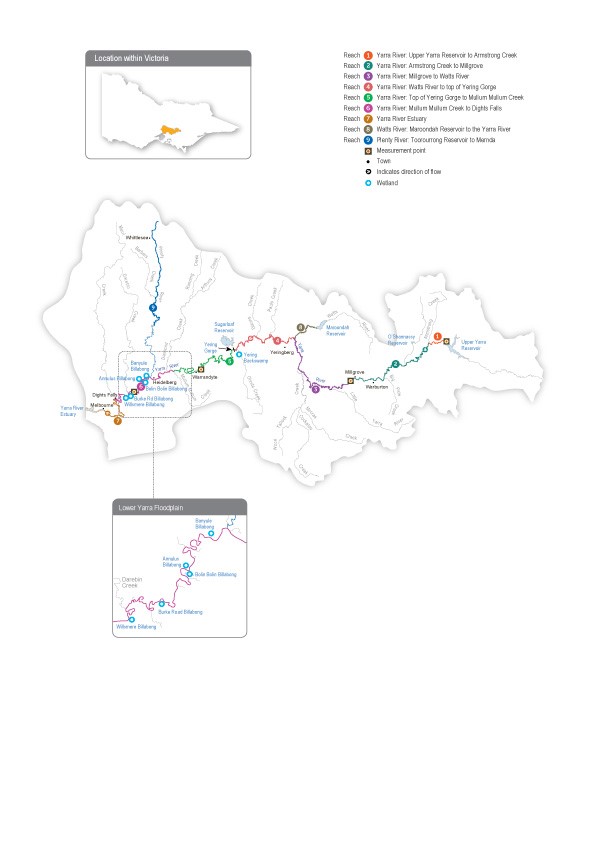Melbourne Water is working with the Registered Aboriginal Parties (RAPs) within the Birrarung (Yarra River) system — the Wurundjeri Woi Wurrung Cultural Heritage Aboriginal Corporation, the Bunurong Land Council Aboriginal Corporation and the Taungurung Land and Waters Council Aboriginal Corporation — to develop and strengthen relationships with them and to increase Traditional Owners’ involvement in the planning and delivery of water for the environment.
Melbourne Water is in discussions with each of the Traditional Owner corporations to work towards developing overarching partnership agreements. In terms of environmental water management, the intent is for Traditional Owners to be active partners in the planning, delivery and monitoring of all deliveries of water associated with Birrarung (Yarra River) and the Plenty River.
The part of the lower Birrarung (Yarra River) floodplain included in the environmental watering program is on Wurundjeri Woi wurrung Country upstream of Chandler Highway. The parts of the lower Birrarung (Yarra River) floodplain on Bunurong Country are not currently in the environmental watering program.
In 2021, changes to the RAP boundaries resulted in the lower Birrarung (Yarra River) from just upstream of Moonee Ponds Creek to Port Phillip Bay now falling within the Bunurong Land Council Aboriginal Corporation’s boundaries. The Bunurong Land Council Aboriginal Corporation is working with the Bunurong people to determine the cultural objectives for the Birrarung (Yarra River) on Bunurong Country.
In early 2023, Melbourne Water met with the Wurundjeri Woi Wurrung Cultural Heritage Aboriginal Corporation to discuss 2023-24 priorities for water for the environment on the lower Birrarung (Yarra River) floodplain. The Wurundjeri Woi Wurrung Cultural Heritage Aboriginal Corporation indicated it supports the priorities for the year ahead.
Where possible, Melbourne Water and the Wurundjeri Woi Wurrung Cultural Heritage Aboriginal Corporation work together to link water for the environment on the lower Birrarung (Yarra River) floodplain with cultural outcomes for the Wurundjeri Woi wurrung people. In general, environmental flows management on the lower Birrarung (Yarra River) floodplain aligns with a landscape-scale approach for billabong watering, developed in consultation with Wurundjeri Woi wurrung people. Management of water for the environment (including wetting and drying) at Annulus, Banyule and Bolin Bolin billabongs is closely aligned with Wurundjeri Woi wurrung aspirations.
Increasing the involvement of Traditional Owners in environmental flows management and progressing opportunities towards self-determination in the environmental watering program is a core commitment of the VEWH and its agency partners. This is reinforced by a range of legislative and policy commitments, including the Water Act 1989, the Victorian Aboriginal Affairs Framework, the 2016 Water for Victoria, the 2022 Central and Gippsland Region Sustainable Water Strategy, the 2022 Water is Life: Traditional Owner Access to Water Roadmap, and in some cases, agreements under the Traditional Owner Settlement Act 2010.
Where Traditional Owners are more deeply involved in the planning and/or delivery of environmental flows for a particular site, their contribution is acknowledged in Table 3.2.1 with an icon. The use of this icon is not intended to indicate that these activities are meeting all the needs of Traditional Owners but is used in the spirit of valuing that contribution.
 | Watering planned and/or delivered in partnership with Traditional Owners to support cultural values and uses |
There are many places of tangible and intangible cultural significance for the Wurundjeri Woi wurrung people and the Bunurong people on the lower Birrarung (Yarra River) floodplain.
A monitoring project continues at the billabongs with the Wurundjeri Woi Wurrung Cultural Heritage Aboriginal Corporation’s Narrap (‘Country’) Unit, the University of Melbourne and Melbourne Water. The group has been monitoring vegetation and water quality outcomes from environmental flows and held an on-Country knowledge-sharing day in 2022 to discuss learnings. The intent is to further the role and leadership of the Wurundjeri Woi Wurrung people in managing the billabongs, including vegetation management, research and being partners in decision-making processes.
In 2023-24, filling Bolin Bolin Billabong in the average and wet scenarios will provide an exit strategy for eels that have entered the billabong while connected with Birrarung (Yarra River). The Narrap Unit suggested this watering action to support the landscape-scale approach to watering floodplain billabongs. The Narrap Unit will collaborate on Bolin Bolin water delivery and monitoring, depending on the unit’s availability in 2023-24.


